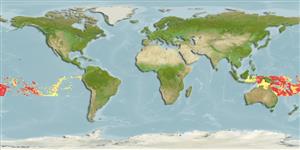Environment: milieu / climate zone / depth range / distribution range
Ekologi
laut; air tawar; payau dasar (demersal); katadromus (ruaya dari air tawar ke laut) (Ref. 51243); kisaran kedalaman 0 - 3000 m (Ref. 86942). Tropical; 1°S - 25°S
Pacific Ocean: Sulawesi, Indonesia to the Society Islands. Also recorded from Pitcairn (Ref. 9828).
Size / Weight / umur
Maturity: Lm ? range ? - ? cm
Max length : 100.0 cm TL jantan/; (Ref. 9828); 165.0 cm SL (female); Berat maksimum terpublikasi: 0.00 g
vertebrata, bertulang belakang: 110 - 114. The only species that can be either variegated or plain-colored. Mottled individuals most closely resemble Anguilla celebensis and A. interioris in having broad, undivided tooth bands, but their ranges do not overlap. Plain-colored individuals most closely resemble A. japonica and A. borneensis, but those species both geographically distant. A. obscura is also plain-colored but has a shorter dorsal fin (Ref. 9828). The skin is grey to yellowish and more or less spotted with brown or black. It can be sometimes uniformly brownish red on the flanks and the back. The belly is white. Young specimens are grey and do not have spots (Ref.48622).
Found in rocky pools, often in coastal streams (Ref. 2847). No separate statistics available (Ref. 9828). The maximum weight (9,000 g) refers to the length (165 cm TL) of a female individual (Ref. 48622).
Life cycle and mating behavior
Kematangan | Reproduksi, perkembang biakan | Pemijahan | telur-telur | Fecundity | Larva
Smith, D.G., 1999. Anguillidae. Freshwater eels. p. 1630-1636. In K.E. Carpenter and V.H. Niem (eds.) FAO species identification guide for fishery purposes. The living marine resources of the WCP. Vol. 3. Batoid fishes, chimaeras and bony fishes part 1 (Elopidae to Linophrynidae). FAO, Rome. (Ref. 9828)
Status IUCN Red List (Ref. 130435)
ancaman kepada manusia
Harmless
penggunaan manusia
Perikanan: komersial
informasi lanjut
Nama-nama umumSinonim (persamaan)metabolismePemangsaEkotoksikologiReproduksi, perkembang biakanKematanganPemijahanSpawning aggregationFecunditytelur-telurpekembangan telor
AcuanBudidaya airprofil budidaya airStrainGenetikaElectrophoresesDiturunkanPenyakit-penyakitPengolahanNutrientsMass conversion
mitraGambarStamps, Coins Misc.Suara-suaraCiguateraKecepatanTipe renangArea insangOtolithsOtakPenglihatan / visi
Alat, peralatan
laporan khas
muat turun XML
Sumber internet
Estimates based on models
Preferred temperature (Ref.
123201): 3.7 - 9.6, mean 4.9 °C (based on 415 cells).
Phylogenetic diversity index (Ref.
82804): PD
50 = 0.5000 [Uniqueness, from 0.5 = low to 2.0 = high].
Bayesian length-weight: a=0.00076 (0.00037 - 0.00155), b=3.17 (3.00 - 3.34), in cm total length, based on LWR estimates for this Genus-body shape (Ref.
93245).
Trophic level (Ref.
69278): 3.8 ±0.7 se; based on size and trophs of closest relatives
Daya lenting (Ref.
120179): sangat rendah, Waktu penggandaan populasi minimum lebih dari 14 tahun (Preliminary K or Fecundity.).
Fishing Vulnerability (Ref.
59153): Very high vulnerability (90 of 100).
